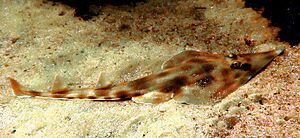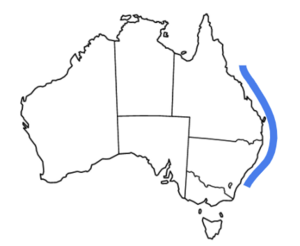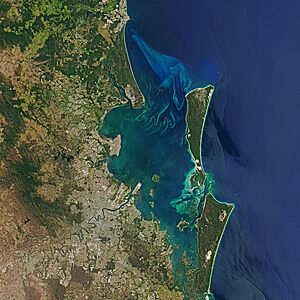Eastern shovelnose ray facts for kids
Quick facts for kids Eastern shovelnose ray |
|
|---|---|
 |
|
| Conservation status | |
| Scientific classification | |
| Synonyms | |
|
Raja rostrata Shaw, 1794 |
The eastern shovelnose ray (Aptychotrema rostrata) is a type of guitarfish. It belongs to the Rhinobatidae family. This ray lives only along the east coast of Australia. You can find it in warm and mild waters from southern Queensland to southern New South Wales.
This ray is a small to medium-sized fish. It can grow up to about 120 centimeters (4 feet) long. Scientists think it might see colors, like humans do. This is because they found special cells in its eyes. Male and female rays have different teeth and jaw shapes. Males have stronger jaws and sharper teeth. This helps them hold onto a female during mating. The eastern shovelnose ray mostly eats fish, shellfish, and small creatures that live on the seafloor. They use their strong jaws and teeth to crush their food.
Eastern shovelnose rays have a yearly breeding cycle. They usually mate in winter and give birth in summer. A mother ray can have between 4 and 20 babies at once. Larger females tend to have more young. The babies grow inside the mother, getting food from a yolk sac. This sac is like a lunchbox that gives them nutrients until they are born.
People catch eastern shovelnose rays for food and sport. Commercial fishing boats in New South Wales and Queensland catch many of them. However, we don't know enough about how they reproduce. This makes it hard to tell if they are truly safe from overfishing.
Contents
What is an Eastern Shovelnose Ray?
The name rostrata comes from Latin. It means 'beaked,' which describes the ray's pointed snout. The eastern shovelnose ray is an elasmobranch. This group includes sharks, rays, skates, and sawfish. These are ancient fish that have jaws. Most elasmobranchs are apex predators. This means they are at the top of the food chain in their ocean homes.
Guitarfish, like the eastern shovelnose ray, are related to sharks. But they look quite different. They have a flat, ray-like body. This shape comes from their head and fins joining together. People call this ray by many names. Some are Australian Shovelnose Ray, Banjo Fish, and Shovelnose Shark. It is closely related to other rays like the eastern fiddler ray and western shovelnose ray.
How Does It Look?
Body Shape and Color
The eastern shovelnose ray is a medium-sized guitarfish. It has a flat, wedge-shaped body. Its snout is long and pointed. It has two fins on its back, both about the same size. These fins are on top of a wide tail.
The ray is usually sandy or brownish in color. It has darker patches on its body. The tip of its snout is blackish. You might see bright orange patches in front of its eyes. Its belly is pale with dark spots. Its eyes are on the top of its head.
Size and Weight
The longest eastern shovelnose ray ever found was about 120 centimeters (4 feet) long. But most adult rays are around 85 centimeters (2.8 feet). Rays in New South Wales tend to be larger than those in Queensland.
The heaviest ray recorded weighed about 4 kilograms (8.8 pounds). Female rays are usually larger and heavier than males.
Inside the Ray: Anatomy
Teeth and Jaws
Male and female eastern shovelnose rays have different teeth and jaw shapes. This helps them during mating. As males grow, their lower jaw becomes more noticeable. Their teeth also get longer and sharper. Adult males also have much stronger jaws than females.
Scientists first thought these differences were for eating different foods. But now we know they help males grip a female's fin during mating. This helps them stay together. The ray's teeth are not fixed to its jawbone. Instead, they are attached to a soft tissue. This allows the ray to replace its teeth constantly, just like sharks.
Seeing Colors
Recent studies show that the eastern shovelnose ray might see colors. They found three types of special cells in its eyes. These cells help it see different colors. This was the first time scientists found this in an elasmobranch. It means that these fish might have more complex vision than we thought.
Scientists used to believe elasmobranchs could only see well in dim light. But the eastern shovelnose ray has many color-sensing cells. It also has eyes that can adjust to bright light. This suggests it sees well in sunny environments.
Where Do They Live?
The eastern shovelnose ray lives only along the east coast of Australia. You can find them from southern Queensland to southern New South Wales. They prefer warm and mild waters.
They usually live in shallow areas. These include mudflats, sandflats, and estuaries (where rivers meet the sea). They also live on rocky reefs. However, some rays have been found in deeper waters, up to 220 meters (720 feet) deep.
What Do They Eat?
The eastern shovelnose ray mainly eats fish, small creatures from the seafloor, and shellfish. More specifically, their diet includes shrimp, prawns, and crabs. Sometimes they eat smaller creatures like amphipods and squid.
Young rays and adult rays eat slightly different things. Adult rays generally eat larger prey. Young rays eat more shrimp.
Elasmobranchs have many different ways of eating. This is because they have been around for a very long time. Shovelnose rays are "suction-crushing feeders." They have a wide mouth and strong jaws. They can suck in large prey and then crush it. Their special teeth help them grind up hard-shelled animals.
Because of their long bodies and fins, scientists think they don't hunt in very deep water. They likely search for food in shallow areas. The eastern shovelnose ray is important to the food chain in Moreton Bay. This is because there are many of them, and they eat many creatures from the seafloor.
How Do They Reproduce?
Breeding Cycle
The eastern shovelnose ray has a yearly breeding cycle. But there are small differences between rays in New South Wales and Queensland. This is probably due to different water temperatures. Generally, they mate in winter (July/August). Females lay eggs in November and give birth in March. The pregnancy lasts about four months.
Females move to shallower waters in summer to give birth. This might be to make sure their babies are born in warmer conditions. Unlike some other guitarfish, summer is not a busy breeding time for this ray. Their pregnancy is shorter than many other guitarfish, which can be pregnant for up to 12 months. Eastern shovelnose rays have one litter of babies each year.
Number of Babies
Knowing how many babies a ray has helps us understand its population. Studies show that a female eastern shovelnose ray can have between 4 and 20 pups. Larger females usually have more babies. Also, larger mothers tend to have larger eggs.
In one study, there were slightly more males than females born. Babies are born around 13 to 15 centimeters (5 to 6 inches) long. Females tend to grow larger and mature earlier than males. Both sexes grow quickly compared to other elasmobranchs. The oldest female found was 11 years old. The oldest male was 8 years old. This was the first time scientists estimated their lifespan.
How Babies Develop
The eastern shovelnose ray is thought to be "yolk sac viviparous." This means the embryos grow inside an egg within the mother's uterus. The embryos are connected to a large yolk sac. This sac provides food, removes waste, and helps them breathe. The yolk sac is used up before the babies are born. This way of reproducing allows many young to develop at the same time.
Why Are They Important to Humans?
Fishing
Commercial fishing boats catch many eastern shovelnose rays. This happens in New South Wales and Queensland. But because we don't know much about their reproduction, it's hard to tell how vulnerable they are. About 75% of the "fiddler" rays caught in New South Wales are eastern shovelnose rays.
More rays are caught in winter than in summer. This might be because they move to shallower waters to give birth. While commercial fishing is the biggest threat, people also catch them for sport. Many people enjoy fishing for them in Moreton Bay. Indigenous Australians also catch a good number of these rays.
As Seafood
The eastern shovelnose ray can be sold and eaten as seafood. The Sydney Fish Market suggests skinning and filleting the tail meat. The meat is firm and usually boneless. It has a mild taste. It goes well with butter, capers, citrus, and rosemary. You can steam, grill, deep-fry, or use it in soups and curries.
How Are They Protected?
A study in the Great Barrier Reef Marine Park looked at the risks of prawn trawling. It found that trawling poses a high risk to the eastern shovelnose ray. Scientists use "post-trawl survival" (PTS) to see how many rays survive after being caught and released. But we don't know much about PTS for this ray.
Studies show that larger rays are more likely to survive after being caught and released. The longer a fishing net is in the water, the lower the ray's chances of survival. The International Union for Conservation of Nature (IUCN) currently lists the eastern shovelnose ray as a species of "least concern." This means they are not currently considered endangered.





